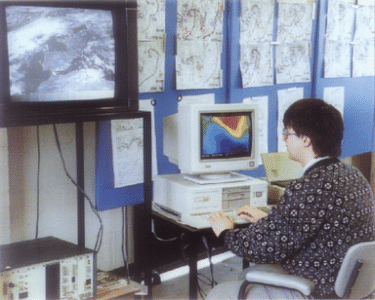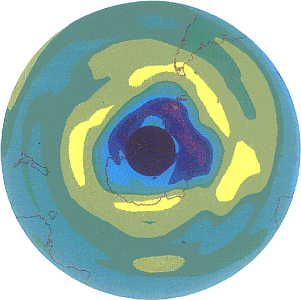


These pages describes undergraduate degrees in Meteorology, read either as a single subject, or in combination with physics or mathematics, or as part of an interdisciplinary degree in environmental science. Fuller details of general University facilities and such topics as English language entrance requirements can be found in the University of Reading Undergraduate Prospectus, available either directly from the Department, by email to bscinfo@reading.ac.uk or by mail or phone (for contact names and addresses, see enquiries page ) or from the Faculty of Science Office (for more information and addresses, see University of Reading page).
All BSc degree courses in the Faculty of Science at the University of Reading are based on a Unit system. Under this system a degree course is normally made up of 48 study modules, each of which is worth 1 credit for the purposes of assessment. One or more modules may be grouped together to form a Unit which is either compulsory or Optional. For a given degree, a student must read a prescribed set of Compulsory Units and select the balance from Optional Units if these are offered as part of the degree course.
The undergraduate degree programme is divided into three Parts:
Part I lasts for two ten-week terms, comprises a total of 12 modules divided into 6 equally weighted units, and culminates in an examination at the beginning of the Summer Term of the first year. A student must pass this examination in order to proceed, but marks from the Part I examination do not contribute to the final degree.
Part II lasts for three ten-week terms and comprises a total of 18 modules divided into units of varying length. Both classwork and written tests or examinations contribute to the assessment of the Part II course, which is completed at the beginning of the Summer Term of the second year.
Part III also lasts for three ten-week terms and comprises a total of 18 modules divided into units of varying length. During the final term at University, students complete and present the results of project work and sit written examinations on Part III modules which have not been assessed entirely on the basis of classwork.
On entry, a student will be registered for a particular BSc degree course, which is normally the course on which he or she has accepted the offer of a place at university following the standard (UCAS) application procedure. However, at the end of Part I it is possible to transfer the degree registration to another course, provided the student has satisfied certain prerequisites which depend on Units read during Part I and the result of the Part I examination. Thus a student originally registered to read Physics and Meteorology (UCAS code FF39) may be able to transfer onto either the degree in Meteorology (UCAS code F950) or the degree in Physics (UCAS code F300). (For further details please contact the appropriate Admissions Tutor, whose name and telephone number are given in the University Undergraduate Prospectus).

COURSE AIMS. The course in Meteorology is intended to suit the needs of students who wish to read physical science to an honours degree level and who have a particular interest in weather and climate. It is particularly suitable for students who are strongly committed to a career in operational or research meteorology, and is the course normally read by vocational meteorologists from overseas who are undergoing advanced training sponsored by the World Meteorological Organisation or other funding agencies.
CAREER POTENTIAL. British graduates qualify for scientific officer entry into the UK Meteorological Office, and if selected would be exempt from some parts of the vocational training programme. Graduates are also qualified for work in the fields of oceanography, hydrology and environmental services. The course contains a sufficient component of pure physics and mathematics that graduates are also qualified to follow a career requiring a university background in these subjects alone.
ENTRY REQUIREMENTS. No prior knowledge of meteorology is required. British students are expected to have good `A' level passes in physics and mathematics, and `A' level or equivalent `AS' level qualifications in at least one other subject. Students without these qualifications or from other European countries are required to offer roughly equivalent grades in examinations such as European Baccalaureate, Scottish School Leaving Certificate or Irish Higher School Leaving Certificate. Lower entry requirements may apply to mature students, though a reasonable background in physics and mathematics is still essential. Vocational students from overseas who do not have the required background in physics and mathematics may be admitted via a one year Preparatory Course at the University of Reading.
COURSE OUTLINE. The Part I course comprises 2 Units of meteorology and either 4 Units of physics with mathematics or 4 Units of mathematics. The topics in meteorology consist of Atmosphere, Oceans and Climate (an introductory lecture course), Synoptic Meteorology (theory and practice of weather system analysis), and Measuring the Atmosphere (mainly practical studies of instruments and atmospheric measurement techniques). Topics in physics with mathematics include Mechanics, Waves and Optics, Electromagnetism and Atomic and Quantum Physics, Applications of Mathematics and Electronics, and Mathematics for Scientists. Topics in mathematics consist of Analysis, Mathematical Methods, Algebra and Vector Methods, and Dynamics.
The Part II course comprises 4 Units of meteorology (worth 11 credits), 3 Compulsory Units of physics and mathematics (worth 3 credits) and a further 4 Optional Units selected from topics in physics, mathematics and a foreign language (worth 4 credits). The topics in meteorology consist of Fluid Motion, Geophysical Fluid Dynamics, Global Circulation, Climate and Climate Change, Radiative Transfer, Cloud Physics, Surface Energy Exchange, General Meteorology, and Numerical Methods in Meteorology. Compulsory topics in physics and mathematics consist of Calculus of Several Variables, Partial Differential Equations and Basic Numerical Analysis, and Classical Mechanics and Relativity. The Optional Units include topics such as Numerical and Differential Equations, and Thermal and Statistical Physics. It is also possible to select an Optional Unit in a foreign language (worth two credits - no prior knowledge of the language required).
The Part III course comprises 1 Compulsory Unit in the form of aMeteorological Project (worth 3 credits) and 15 Compulsory Units in Meteorology and other geophysical subjects (worth 15 credits). The topics in meteorology include Tropical Meteorology, Middle Latitude Meteorology, Boundary Layer Meteorology, Micrometeorology, Atmospheric Analogue Experiments, Statistical Climatology, Numerical Weather Prediction, and Agricultural Meteorology. Other topics include Oceanography, Remote Sensing, and Hydrology. During Part III, students reading Meteorology also carry out studies of current weather situations and present results during weekly Departmental Weather Discussions.

COURSE AIMS. The combined course in Physics and Meteorology is primarily intended for students who wish to study physical science at university, and who are particularly interested in the application of physics to the understanding of environmental problems. Topics in the two study areas have been carefully selected to provide the student with a sound knowledge of classical and modern physics as well as meteorology.
CAREER POTENTIAL. The course provides an excellent route for those wishing to pursue a career in meteorology or a closely related environmental science whilst retaining a wide interest in general physics. Graduates qualify for scientific officer entry into the UK Meteorological Office, and if selected would be exempt from some parts of the vocational training programme. Graduates will have received a training which will also enable them to continue with a career as a physicist if they so wish, and in this field they are well qualified to compete with graduates from courses in pure and/or applied physics.
ENTRY REQUIREMENTS. No prior knowledge of meteorology is required. Students are normally expected to have good `A' level passes in physics mathematics, and `A' level or equivalent `AS' level qualifications in at least one other subject. (For further details, see under entry requirements for the BSc degree course in Meteorology.)
COURSE OUTLINE. The Part I course comprises 2 Units of meteorology and 4 Units of physics with mathematics. The topics in meteorology consist of Atmosphere, Oceans and Climate and (an introductory lecture course), Synoptic Meteorology (theory and practice of weather system analysis), and Measuring the Atmosphere (mainly practical studies of instruments and atmospheric measurement techniques). Topics in physics with mathematics include Mechanics, Waves and Optics, Electromagnetism and Atomic and Quantum Physics, Applications of Mathematics and Electronics, and Mathematics for Scientists.
The Part II course comprises 3 Units of meteorology (worth 9 credits) and 8 Units of physics with some additional mathematics (worth 9 credits). The topics in meteorology consist of Fluid Motion, Geophysical Fluid Dynamics, Global Circulation, Climate and Climate Change, Radiative Transfer, Cloud Physics, Surface Energy Exchange, and Numerical Methods in Meteorology. The topics in physics include Classical Mechanics and Relativity, Thermal and Statistical Physics, Electromagnetism, Condensed Matter, and Quantum Mechanics and Atomic and Molecular Physics. Additional topics in mathematics consist of Partial Differential Equations and Basic Numerical Analysis, and Calculus of Several Variables.
The Part III course comprises 7 Units of meteorology (worth 9 credits) and 9 Units of physics (worth 9 credits). In meteorology, the student carries out a Meteorological Project (worth 3 credits) and selects a further 6 lecture and practical course modules. These include topics such as Tropical Meteorology, Middle Latitude Meteorology, Boundary Layer Meteorology, Micrometeorology, Atmospheric Analogue Experiments, Statistical Climatology, Numerical Weather Prediction, Agricultural Meteorology, Hydrology, Remote Sensing, and Oceanography. In physics, the student carries out a short project (worth 1 credit) and reads a further 8 lecture and practical course modules. These include topics such as Nuclear and Particle Physics, Electromagnetism, Thermal and Statistical Physics, Atomic and Molecular Physics, Condensed Matter, and Computational Physics. Students also carry out studies of current weather situations and present results during weekly Departmental Weather Discussions.

COURSE AIMS. The combined course in Mathematics and Meteorology is designed to suit the needs of students who wish to read mathematics at university, and who are particularly interested in the application of mathematical techniques to the understanding of environmental problems.
CAREER POTENTIAL. The course provides an excellent route for those wishing to pursue a career in meteorology or a closely related environmental science whilst retaining a wide interest in pure and applied mathematics. Graduates qualify for scientific officer entry into the UK Meteorological Office, and if selected would be exempt from some parts of the vocational training programme. Graduates will also have received a training which will enable them to continue with a career in mathematics if they so wish, and in this field they are well qualified to compete with graduates in pure and applied mathematics.
ENTRY REQUIREMENTS. No previous knowledge of meteorology is required. Students are expected to have good `A' level passes in either two mathematical subjects or mathematics and physics. Students who have not read physics to `A' level are expected to have at least grade C in Combined Science or Physics at GCSE/O level. `A' level or equivalent `AS' level qualifications are also required in at least one other subject. (For further details, see under entry requirements for the BSc degree course in Meteorology.)
COURSE OUTLINE. The Part I course comprises 2 Units of meteorology and 4 Units of mathematics. The topics in meteorology consist of Atmosphere, Oceans and Climate (an introductory lecture course), Synoptic Meteorology (theory and practice of weather system analysis), and Measuring the Atmosphere (mainly practical studies of instruments and atmospheric measurement techniques). The topics in mathematics consist of Analysis, Mathematical Methods, Algebra, and Vector Methods and Dynamics.
The Part II course comprises 3 Units of meteorology (worth 9 credits) and 5 Units in mathematics (worth 9 credits). The topics in meteorology consist of Fluid Motion, Geophysical Fluid Dynamics, Global Circulation, Climate and Climate Change, Radiative Transfer, Cloud Physics, Surface Energy Exchange, and Numerical Methods in Meteorology. Topics in mathematics include Linear Algebra and Analysis, Vector Field Theory and Dynamics, Differential Equations, Numerical Analysis, and Calculus and Analysis.
The Part III course comprises a Compulsory Unit in the form of a numerically based Meteorological Project (worth 3 credits), a combination of Compulsory and Selected units in meteorology (worth 6 credits), and Selected units in mathematics (worth 9 credits). Compulsory topics in meteorology consist of Tropical Dynamics, Middle Latitude Dynamics, and Ocean Dynamics, whilst Selected units are chosen from topics which include Boundary Layer Meteorology, Micrometeorology, Ocean Science, Statistical Climatology, Hydrology, Remote Sensing, and Numerical Weather Prediction. There is a wide choice of optional topics in mathematics which include Numerical Analysis and Optimisation, Generalized Dynamics, Combinatorics, Complex Analysis, Calculus of Variations, Numerical Solution of Differential Equations, Partial Differential Equations, Extremum Principles and Asymptotic Methods, and Control Theory and Special Functions.

COURSE AIMS. The course in Environmental Science of the Earth and Atmosphere is an interdisciplinary course which emphasises the interactions between the atmosphere, lithosphere and oceans, with the influence of mankind on these interactions very much in mind. It is designed to suit the needs of students with wide-ranging science, environmental science or physical science interests. The course emphasises quantitative aspects of this interdisciplinary science so that students emerge from the course with a sound scientific training.
CAREER POTENTIAL. It is expected that graduates from this course will find a wide range of environmentally related employment opportunities including water companies, environmental consultants, and the many offices of national and local governments concerned with environmental issues. Opportunities also exist in private industry which is increasingly concerned to employ scientists to help minimize adverse environmental impact of their activities.
ENTRY REQUIREMENTS. No prior knowledge of meteorology, geology or environmental science is required. Students are expected to gain at least 20 points in `A' and `AS' level examinations, including a good `A' level pass in at least one of the following: Chemistry, Physics, Biology, Mathematics, Environmental Studies. A GCSE/O grade C pass is required in Mathematics and either double integrated Science or one of Chemistry, Physics or Biology. Mature students and potential applicants with different qualifications are invited to contact the Admissions Tutor for this course, whose name and telephone number can be found in the University Undergraduate Prospectus.
COURSE OUTLINE. The Part I course comprises 4 Units of taught course work plus 1 Unit in the form of a Field Class. The taught Units consist of Introductory Geology (3 credits), Meteorology I (3 credits), Soil Science (3 credits), and Scientific Principles of Environmental Science (3 credits). The field class takes place within the British Isles, and involves carrying out environmental measurements which relate to topics covered in the taught Units.
The Part II course comprises 9 Units of taught course work plus 1 Unit in the form of a Field Class. The taught Units (each worth 2 credits) consist of Soil Properties and Processes, Soft Rock Geology, Meteorology II, Soil Chemistry and Biochemistry, Sedimentary Geochemistry, Climate and Ocean Science, Hydrology, Environmental Systems Numerical Methods and Sampling. The Field Class takes place abroad and offers the student the opportunity of studying a new environment using many of the techniques discussed in the Part II Units.
The Part III course comprises 4 Compulsory Units (worth a total of 12 credits) plus a Selected Unit and a choice of optional course modules (worth 6 credits). The Compulsory Units consist of Monitoring the Environment, Environmental Management and Policy, Field Based Project and Laboratory/Library Project. Selected Units and Optional course modules include more specialized topics such asThe Climate System, Environmental and Management Studies, Environmental Chemistry, Conservation and Management of Resources and Soil/Plant/Atmosphere Interactions.
Enquiries are always welcomed.
Enquiries concerning the academic content of the courses should be addressed to:
Department of Meteorology
Telephone: (0734) 318954 (UK); +44 734 318954 (International)
Fax: (0734) 352604 (UK); +44 734 352604 (International)
Telex: 847813
email: bscinfo@met.reading.ac.uk
Enquiries concerning financial conditions and English proficiency should be addressed to
The Sub-Dean
Faculty of Science
University of Reading
Whiteknights
PO Box 217
Reading
RG6 2AH
UK
Telephone: (0734) 318343 (UK); +44 734 318343 (International)
Fax: (0734) 314404 (UK); +44 734 314404 (International)
Telex: 847813
Enquiries concerning admission standards should be addressed to the Admissions Tutor of the relevant course, whose name and telephone number can be found in the University of Reading Undergraduate Prospectus.